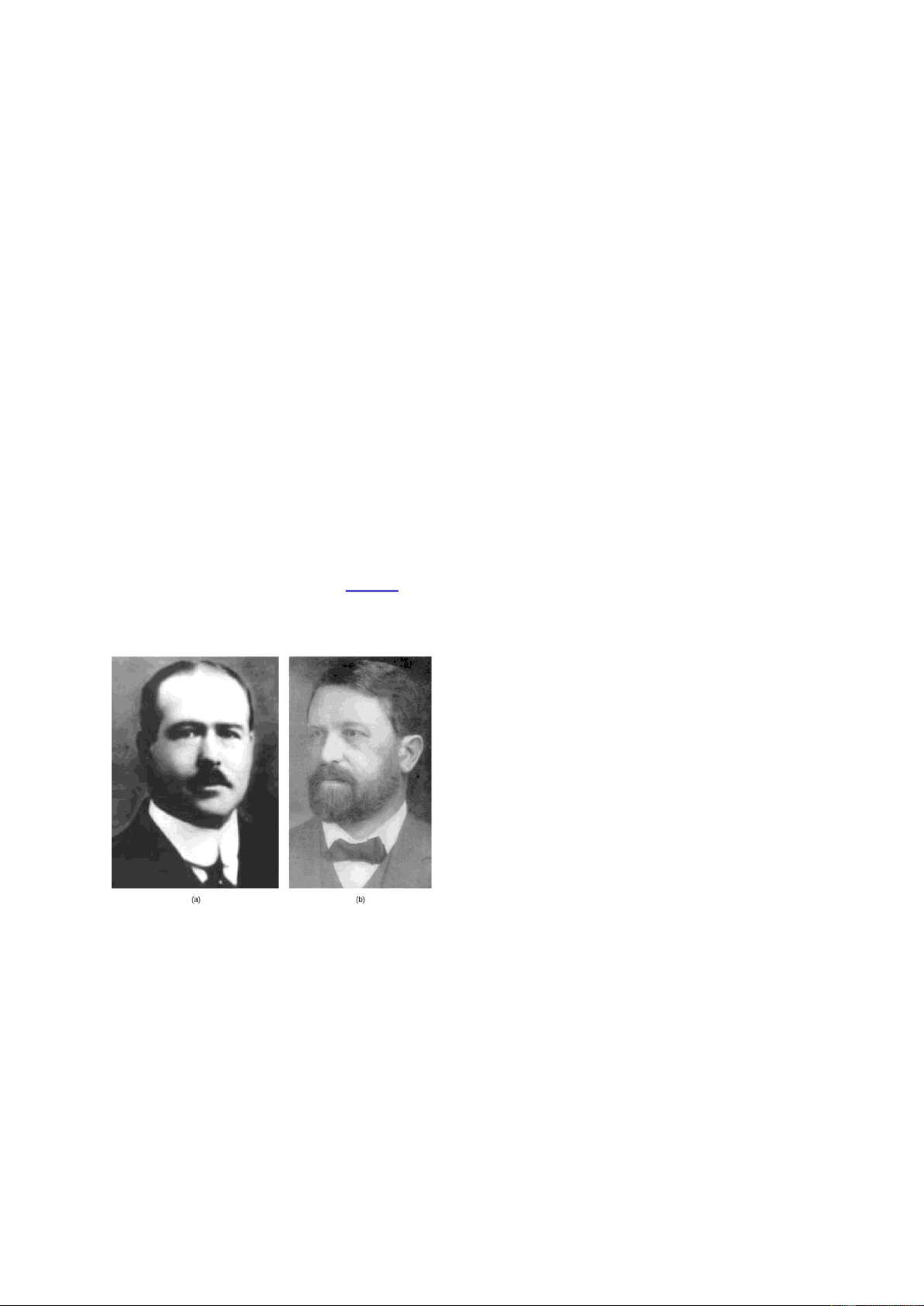


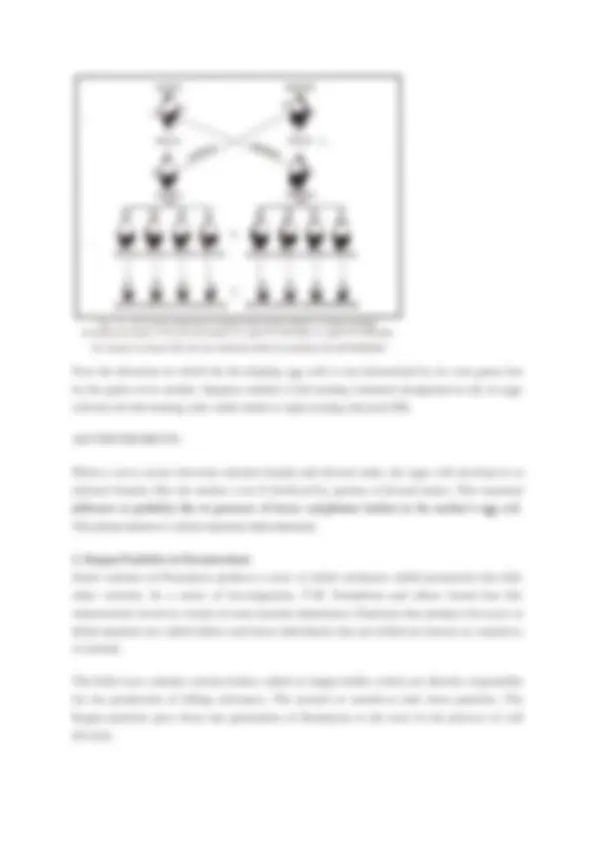
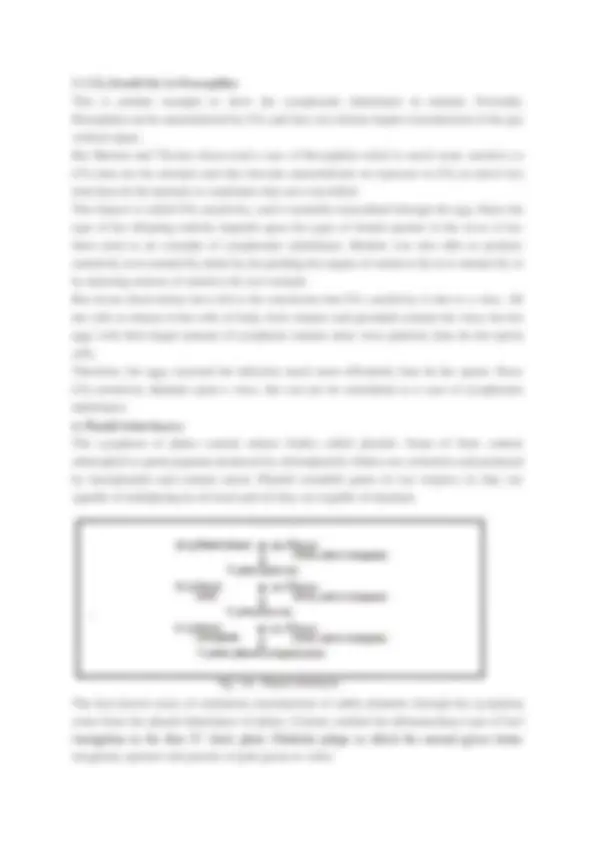

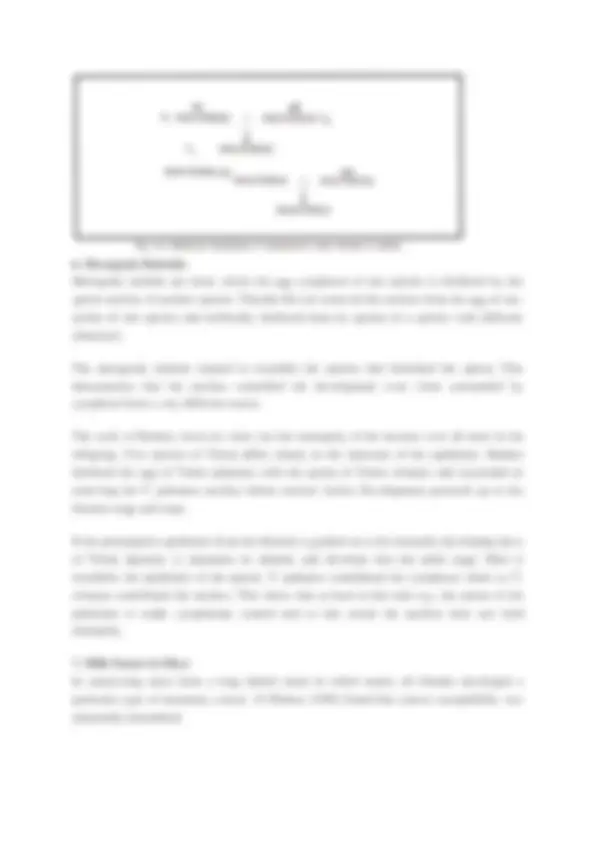


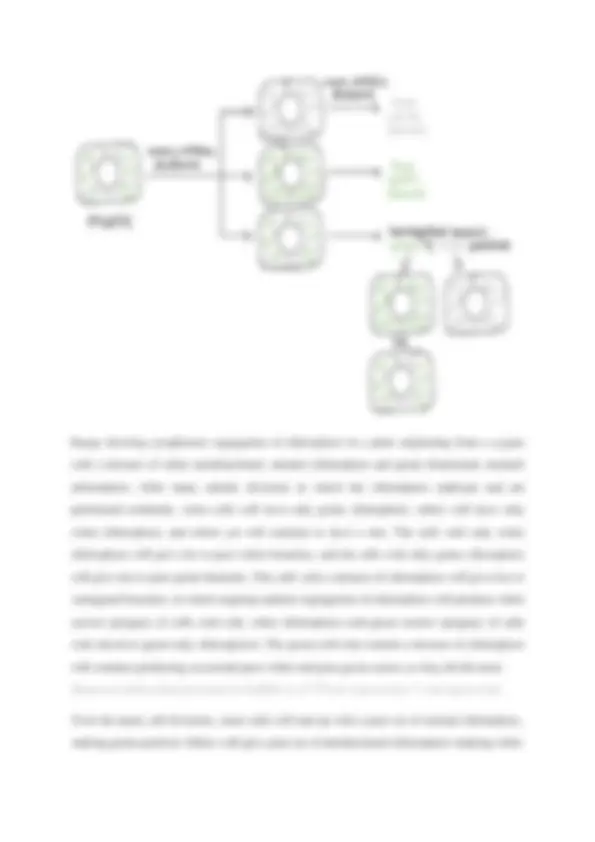
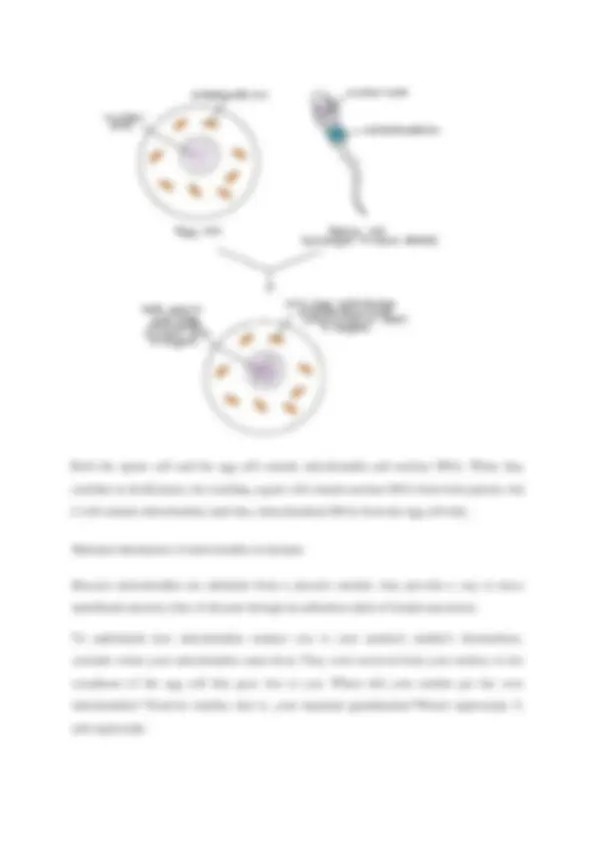
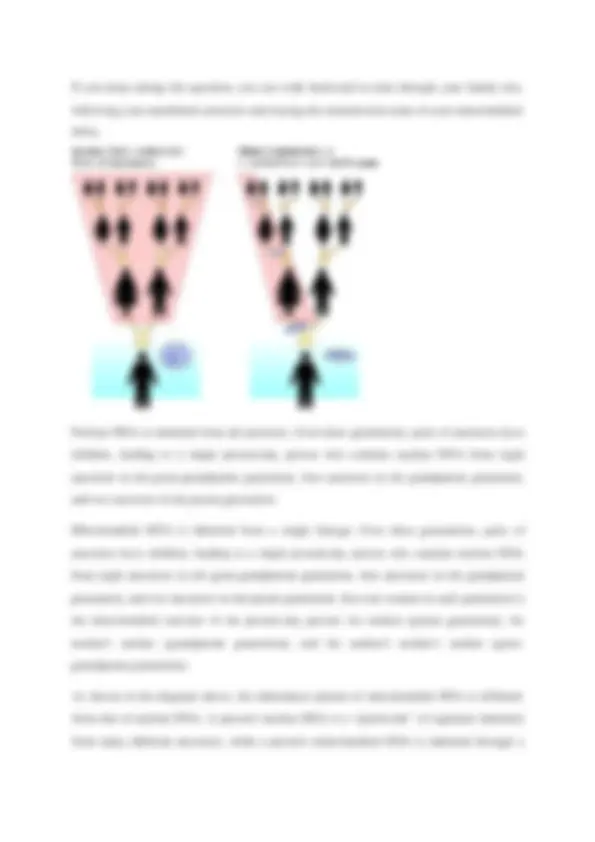

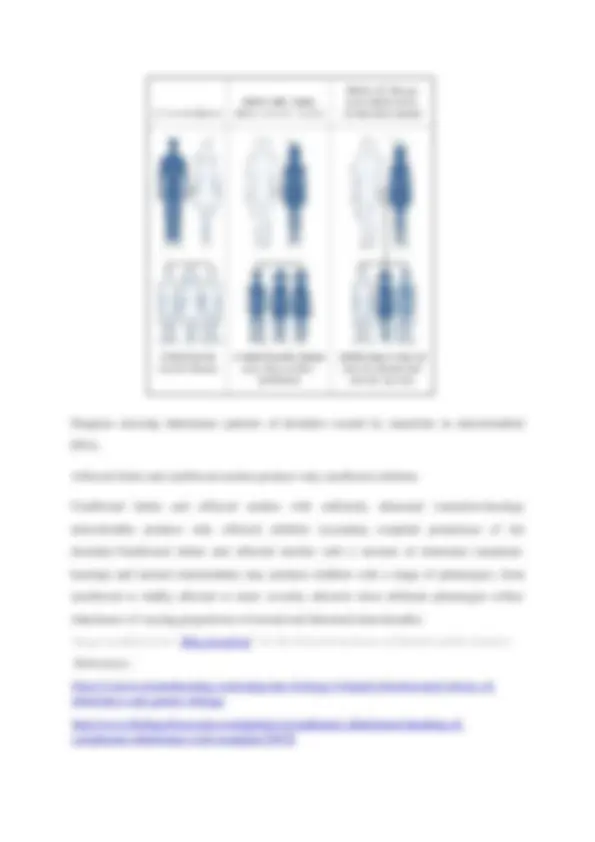



Study with the several resources on Docsity

Earn points by helping other students or get them with a premium plan


Prepare for your exams
Study with the several resources on Docsity

Earn points to download
Earn points by helping other students or get them with a premium plan
Community
Ask the community for help and clear up your study doubts
Discover the best universities in your country according to Docsity users
Free resources
Download our free guides on studying techniques, anxiety management strategies, and thesis advice from Docsity tutors
Walter Sutton and Theodor Boveri said that chromosomes carry the inheritence from parents to offsprings.
Typology: Lecture notes
1 / 22

This page cannot be seen from the preview
Don't miss anything!















Course Code-EDU161 and Course Name:Botany
Chromosomal Theory of Inheritance
Long before chromosomes were visualized under a microscope, the father of modern genetics, Gregor Mendel, began studying heredity in 1843. With the improvement of microscopic techniques during the late 1800s, cell biologists could stain and visualize subcellular structures with dyes and observe their actions during cell division and meiosis. With each mitotic division, chromosomes replicated, condensed from an amorphous (no constant shape) nuclear mass into distinct X-shaped bodies (pairs of identical sister chromatids), and migrated to separate cellular poles.
Chromosomal Theory Of Inheritance
The speculation that chromosomes might be the key to understanding heredity led several scientists to examine Mendel‘s publications and re-evaluate his model in terms of the behavior of chromosomes during mitosis and meiosis. In 1902, Theodor Boveri observed that proper embryonic development of sea urchins does not occur unless chromosomes are present. That same year, Walter Sutton observed the separation of chromosomes into daughter cells during meiosis ( Figure ). Together, these observations led to the development of the Chromosomal Theory of Inheritance, which identified chromosomes as the genetic material responsible for Mendelian inheritance.
(a) Walter Sutton and (b) Theodor Boveri are credited with developing the Chromosomal Theory of Inheritance, which states that chromosomes carry the unit of heredity (genes).
The Chromosomal Theory of Inheritance was consistent with Mendel‘s laws and was supported by the following observations:
During meiosis, homologous chromosome pairs migrate as discrete structures that are independent of other chromosome pairs. The sorting of chromosomes from each homologous pair into pre-gametes appears to be random. Each parent synthesizes gametes that contain only half of their chromosomal complement.
Even though male and female gametes (sperm and egg) differ in size and morphology, they have the same number of chromosomes, suggesting equal genetic contributions from each parent. The gametic chromosomes combine during fertilization to produce offspring with the same chromosome number as their parents.
Despite compelling correlations between the behaviour of chromosomes during meiosis and Mendel‘s abstract laws, the Chromosomal Theory of Inheritance was proposed long before there was any direct evidence that traits were carried on chromosomes. Critics pointed out that individuals had far more independently segregating traits than they had chromosomes. It was only after several years of carrying out crosses with the fruit fly, Drosophila melanogaster , that Thomas Hunt Morgan provided experimental evidence to support the Chromosomal Theory of Inheritance.
Genes in the chromosomes have undoubtedly been proved to be responsible for the transmission of the various hereditary characters which in turn are located in the nucleus.
But in recent years there have been found some evidences which suggest that inheritance of characters occur by some self-perpetuating or replicating bodies like plastids and mitochondria which possess their own equipment for synthesizing for DNA and proteins present in the cytoplasm and not in the chromosomes present in the nucleus.
This particular type of mechanism in which cytoplasmic particles or inclusions take part in transmission of characters from generation to generation constitutes cytoplasmic inheritance.
The total self reproducing hereditary material of cytoplasm is termed as Plasmon like the genome (which refers to the total gene complement of an haploid set of chromosomes) of chromosomes and such units of cytoplasmic hereditary material are called cytoplasmic genes or plasma-genes or Plasmon‘s.
The cytoplasmic hereditary units are denoted by Greek letters-alpha, beta, gamma, sigma and so on, in contrast to the chromosomal genes which are denoted by Roman letters- a, b, c, d and so on. While considering various examples of cytoplasmic inheritance it has been assumed that the cytoplasm in the sperm cell is present in very minute quantity and mostly it is in larger quantity in the egg.
So, we could expect that plasma-genes mostly will transmit only through the egg cytoplasm rather than minute sperm. Thus, plasma-genes for various sizes and characters are likely to be supposed only in the egg cytoplasm.
The colour depends upon the presence of pigments. The synthesis of pigment is controlled by a hormone like substance known as Kynurenine. The hormone like substance is controlled by allele ‗A‘ and the absence of the substance is due to the presence of allele ‗a‘ in a homozygous condition.
In the progeny of cross I and II, individuals of the constitution aa, should not show any pigment but the situation is some what different. The progeny of cross I with the constitution ‗a‘ develop pigments in the skin and eyes in the larval stage; while those of cross II shows no pigment in the larval stage.
So, it became very clear that the presence or absence of pigment seems to depend upon the type of mother and on the cytoplasm, which offspring got through the ovum. Having got it through the cytoplasm, it may be cited as an example of cytoplasmic inheritance.
The real explanation is different. Allele ‗A‘ elaborates the hormone like substance, kynurenine and this finds place in both type of ova ‗A‘ and ‗a‘ at the time of oogenesis. The small amount in the ovum ‗a‘ is responsible for the development of pigments in the larva with the constitution aa.
But the pigments thus developed is only temporary and is lost in the adult. Since this is not permanent and is not transferred to subsequent generations. Some authors consider that this is not example of cytoplasmic inheritance at all.
(b) In snail Limnaea: An example of inheritance determined by female (mother) eggs is described in water snail Limnaea by Boycott Diver and Garstang on its coiling. The dextral or right coiling is represented by dominant (DD) while its recessive is sinistral or left coiling (dd).
Now the direction in which the developing egg coils is not determined by its own genes but by the genes of its mother. Suppose mother is left turning (sinistral) designated as dd, its eggs will also be left turning coils while father is right turning (dextral) DD.
ADVERTISEMENTS:
When a cross occurs between sinistral female and dextral male, the eggs will develop in to sinistral females like the mother even if fertilized by sperms of dextral males. This maternal influence is probably due to presence of some cytoplasmic bodies in the mother‘s egg cell. This phenomenon is called maternal determination.
2. Kappa Particles in Paramecium: Some varieties of Paramecia produce a toxic or lethal substance called paramecin that kills other varieties. In a series of investigations, T.M. Sonneborn and others found that this characteristic involves a kind of extra-nuclear inheritance. Parmecia that produce the toxic or lethal material are called killers and those individuals that are killed are known as sensitives or normal.
The killer race contains certain bodies called as kappa bodies which are directly responsible for the production of killing substance. The normal or sensitives lack these particles. The Kappa particles pass from one generation of Paramecia to the next in the process of cell division.
Certain killer clones ‗KK‘ or ‗Kk‘ can be converted in to sensitives by making them undergo very rapid fissions (amitosis cell division as in bacteria or prokaryotes) at high temperature, during which the reproduction of kappa fails to keep distance or pace with the cell divisions.
As a result of this, the number of kappa per Paramecium becomes fewer and fewer in the course of the cell division and eventually some paramecia are left without any kappa particles and become sensitives. Thereafter, the gene ‗K‘ can not initiate the production of the particles but can again maintain them if they are introduced during conjugation.
The exact nature of kappa has not been known. Some biologists consider that kappa is an symbiont organism and others think that it might be a gene present in the cytoplasm. So at present it is impossible to decide between the two theories.
In any case, kappa is capable of specific self duplication; it is found in the cytoplasm of the cell and it is normally transmitted from generation to generation. It has also been shown that kappa particles contain DNA.
Until the true nature of kappa is definitely settled, kappa can not be considered as an evidence for cytoplasmic genes. E. Altenburg suggests that kappa was derived from Zoochlorellae and in the course of evolution had lost their chlorophyll and assumed additional properties like killing etc.
3. CO 2 Sensitivity in Drosophila: This is another example to show the cytoplasmic inheritance in animals. Normally Drosophila can be anaesthetized by CO 2 and they can tolerate higher concentration of the gas without injury. But Heritier and Teissier discovered a race of Drosophila which is much more sensitive to CO 2 than are the normals and they become anaesthetized on exposure to CO 2 in much less time than do the normals or sometimes they are even killed. This feature is called CO 2 sensitivity, and is normally transmitted through the egg. Since the type of the offspring entirely depends upon the types of female parents in the cross; it has been cited as an example of cytoplasmic inheritance. Heritier was also able to produce sensitivity in to normal fly either by the grafting the organs of sensitive fly in to normal fly or by injecting extracts of sensitive fly in to normal. But recent observations have led to the conclusion that CO 2 sensitivity is due to a virus. All the cells or almost of the cells of body, both somatic and germinal contain the virus, but the eggs with their larger amount of cytoplasm contain more virus particles than do the sperm cells. Therefore, the eggs, transmit the infection much more efficiently than do the sperm. Since CO 2 sensitivity depends upon a virus, this can not be considered as a case of cytoplasmic inheritance. 4. Plastid Inheritance: The cytoplasm of plants contain minute bodies called plastids. Some of them contain chlorophyll or green pigment produced by chloroplastids. Others are colourless and produced by leucoplastids and contain starch. Plastids resemble genes in two respects (i) they are capable of multiplying by division and (ii) they are capable of mutation.
The best known cases of continuous transmission of stable elements through the cytoplasm come from the plastid inheritance of plants. Correns studied the albomaculatus type of leaf variegation in the four O‘ clock plant, Mirabilis jalapa in which the normal green tissue irregularly spotted with patches of pale green or white.
6. Merogonic Hybrids: Merogonic hybrids are those where the egg cytoplasm of one species is fertilized by the sperm nucleus of another species. Theodor Boveri removed the nucleus from the egg of sea- urchin of one species and artificially fertilized them by sperms of a species with different characters.
The merogonic hybrids seemed to resemble the species that furnished the sperm. This demonstrates that the nucleus controlled the development even when surrounded by cytoplasm from a very different source.
The work of Hadorn, however, rules out this monopoly of the nucleus over all traits in the offspring. Two species of Triton differ clearly in the character of the epidermis. Hadorn fertilized the egg of Triton palmatus with the sperm of Triton cristatus and succeeded in removing the T. palmatus nucleus before nuclear fusion. Development proceeds up to the blastula stage and stops.
If the presumptive epidermis from the blastula is grafted on to the normally developing larva of Triton alpestris, it maintains its identity and develops into the adult stage. Here it resembles the epidermis of the parent. T. palmatus contributed the cytoplasm where as T. cristatus contributed the nucleus. This shows that at-least in this trait e.g., the nature of the epidermis is under cytoplasmic control and to this extent the nucleus does not hold monopoly.
7. Milk Factor in Mice: In outcrossing mice from a long inbred strain in which nearly all females developed a particular type of mammary cancer. J.J Bittner (1940) found that cancer susceptibility was maternally transmitted.
Moreover, when baby mice from lines showing respectively high and low incidence of cancer were taken from their mothers at birth, and allowed to nurse on foster mothers of the opposite type, it was shown that the substance that induces cancer susceptibility is transmitted through mother‘s milk i.e., mother mice from lines showing a high incidence of the disease transmit through their milk a substance that later causes mammary cancer to develop in mice that have nursed from them.
These results established a maternal inheritance dependent on a factor carried in the milk. More recent studies have shown that the factor is transmitted also by body fluids other than milk including saliva and semen. Recent evidences suggest that this disease is probably due to virus. So this offers no support for the theory that the cytoplasm contains genes.
Predetermination and Dauermodifications: Mostly maternally transmitted characters are due to cytoplasmic inheritance. However, there are certain cases where the maternally transmitted cases are not governed by cytoplasmic inheritance. The egg cell which develops within mother‘s body, its cytoplasm is well affected by the mother‘s gene as well as by the substances produced within mother‘s body itself.
All of these affect some of the characters of embryo. This effect of the maternal genes on the cytoplasm of egg cell is called predetermination and the characters affected are said to be predetermined. Example of this type is the direction of coiling in snails and development of cancer in the breast of female mice at maturity stage. The gene for this case is transmitted to the young ones through the mothers milk.
Occasionally phenotypic changes are produced as a result of the environmental factors or chemicals and are transmitted through the cytoplasm of the egg cell. The changes so far produced insist for a few generations but gradually comes to declinity and finally get disappeared. These are called dauermodifications. These are never gene controlled characters and disobey Mendelian traits
Mitochondrial and chloroplast DNA and why its inheritance does not follow Mendelian patterns.
Introduction
If you were asked to name the organelle that contains DNA, what would you say? If you said
the nucleus, you'd definitely get full points, but the nucleus is not the only source of DNA in
most cells.
Here are some ways that mitochondrial and chloroplast DNA differ from the DNA found in the nucleus:
High copy number. A mitochondrion or chloroplast has multiple copies of its DNA, and a
typical cell has many mitochondria (and, in the case of a plant cell, chloroplasts). As a result, cells usually have many copies – often thousands – of mitochondrial and chloroplast DNA.
Random segregation. Mitochondria and chloroplasts (and the genes they carry) are
randomly distributed to daughter cells during mitosis and meiosis. When the cell divides, the organelles that happen to be on opposite sides of the cleavage furrow or cell plate will end up in different daughter cells^3 3 cubed.
Single-parent inheritance. Non-nuclear DNA is often inherited uniparentally, meaning that
offspring get DNA only from the male or the female parent, not both^4 4 start superscript, 4, end superscript. In humans, for example, children get mitochondrial DNA from their mother (but not their father).
Chloroplast inheritance: Early experiments
At the turn of the 20th century, Carl Correns, a German botanist, did a series of genetic experiments using four o‘clock plants ( Mirabilis jalapa ). We now know that his work demonstrated how chloroplast DNA is passed on from cell to cell and from parent to offspring—though Correns himself didn't know it at the time^5 5 start superscript, 5, end superscript!
Correns' experiments
The Mirabilis plants that Correns worked with came in three types: pure green, pure white, or variegated (mottled green and white). Green and white branches could appear on variegated plants, but variegated branches did not appear on green or white plants^6 6 start superscript, 6, end superscript.
Correns was curious about this coloration trait, and he carried out a number of crosses between plants of different colors. He found that^6 6 start superscript, 6, end superscript:
The color of the egg cell-donating branch (female parent) determined the color of the
offspring.
Female parent branches that were pure green or pure white produced only pure green or pure
white offspring, respectively.
Female parent branches that were variegated could produce all three types of offspring, but
not in any predictable ratios. Correns speculated that some factor in the cytoplasm of the egg cell must determine the color of the offspring. It was actually a different German botanist, Erwin Baur, who suggested that the chloroplasts in the cytoplasm might carry hereditary factors (genes)^5 5 start superscript, 5, end superscript.
Baur thought that, in variegated plants, some of the chloroplasts must have mutations that made them unable to turn green (produce pigment). Today, we know that this hypothesis was exactly right!
Explaining Correns' results
How can the idea of chloroplast inheritance make variegated plants variegated? Let's follow a zygote (1-celled embryo) with mixture of chloroplasts inherited from the egg cell. Some of the chloroplasts are green, while others are white. As the zygote undergoes many rounds of mitosis to form an embryo and then a plant, the chloroplasts also divide and are distributed randomly to daughter cells at each division.
patches). Others yet will have a mix of normal and nonfunctional chloroplasts, producing
green patches that may give rise to pure green or pure white sectors^7 7 start superscript, 7,
end superscript.
What about the maternal pattern of inheritance? Plants make germ cells late in development,
converting cells at the tip of a branch into gamete-producing cells. A branch that‘s pure green
will make egg cells with green chloroplasts that give rise to pure green offspring. Similarly, a
branch that's pure white will make egg cells that contain only white chloroplasts and will give
rise to pure white offspring.
If a branch is variegated, it has a mixture of cells, some with only functional chloroplasts,
some with only nonfunctional chloroplasts, and some with a mixture of chloroplasts. All
three of these cell types may give rise to egg cells, leading to the green offspring, white
offspring, and variegated offspring in unpredictable ratios^{6,7}
Female
branch Egg cells Zygotes Offspring
Variegated
branch
Egg cell with green chloroplasts, egg cell with white chloroplasts, or egg cell with mixed
Egg cell with white chloroplasts leads to zygote with white chloroplasts; egg cell with green chloroplasts leads to zygote with green chloroplasts; egg cell with mixture of chloroplasts
Variegated plant
Female
branch Egg cells Zygotes Offspring
chloroplasts leads to zygote with mixture of chloroplasts
Based on similar diagram found in Griffiths et al.
Mitochondrial inheritance
Mitochondria, like chloroplasts, tend to be inherited from just one parent or the other (or at
least, to be unequally inherited from the two parents)^4 4 start superscript, 4, end superscript.
In the case of humans, it is the mother who contributes mitochondria to the zygote, or one-
celled embryo, by way of the egg's cytoplasm. Sperm do contain mitochondria, but they are
not usually inherited by the zygote. There has been a reported case of paternal inheritance of
mitochondria in a human, but this is extremely rare^8 8 start superscript, 8, end superscript.
If you keep asking this question, you can walk backward in time through your family tree, following your matrilineal ancestors and tracing the transmission route of your mitochondrial DNA.
Nuclear DNA is inherited from all ancestors. Over three generations, pairs of ancestors have
children, leading to a single present-day person who contains nuclear DNA from eight
ancestors in the great-grandparent generation, four ancestors in the grandparent generation,
and two ancestors in the parent generation.
Mitochondrial DNA is inherited from a single lineage. Over three generations, pairs of
ancestors have children, leading to a single present-day person who contains nuclear DNA
from eight ancestors in the great-grandparent generation, four ancestors in the grandparent
generation, and two ancestors in the parent generation. Just one woman in each generation is
the mitochondrial ancestor of the present-day person: his mother (parent generation), his
mother's mother (grandparent generation), and his mother's mother's mother (great-
grandparent generation).
As shown in the diagram above, the inheritance pattern of mitochondrial DNA is different from that of nuclear DNA. A person's nuclear DNA is a "patchwork" of segments inherited from many different ancestors, while a person's mitochondrial DNA is inherited through a
single, unbroken line of female ancestors^{9,10} 9 , 10 start superscript, 9, comma, 10, end superscript.
Mitochondrial mutations and human disease
Mutations in mitochondrial DNA can lead to human genetic disorders. For example, large deletions in mitochondrial DNA cause a condition called Kearns-Sayre syndrome. These deletions keep the mitochondria from doing their job of extracting energy. Kearns-Sayre syndrome can cause symptoms such as weakness of the muscles, including those that control eyelid and eye movement, as well as degeneration of the retina and development of heart disease^{11,12} 11 , 12 start superscript, 11, comma, 12, end superscript.
Genetic disorders caused by mitochondrial mutations are not transmitted from fathers to children, because mitochondria are provided only by the mother. Instead, they are transmitted from mothers to children in one of the following ways^{13} 13 start superscript, 13, end superscript:
A person with a disease caused by a mitochondrial mutation may lack normal mitochondria
(and have only abnormal, mutation-bearing ones). In this case, an affected mother will always pass on mutation-bearing mitochondria to her children.
A mitochondrial disorder may occur when a person has a mix of normal and abnormal
mitochondria her body. In this case, normal and mutation-bearing mitochondria may go randomly into eggs during meiosis. Children who get a large proportion of mutant mitochondria may have severe disease, while those with few mutant mitochondria may have mild or no disease^{13} 13 start superscript, 13, end superscript.